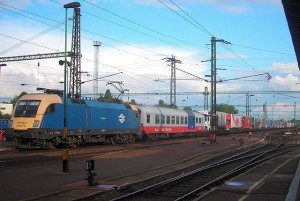French and Spanish authorities and companies have recently taken several steps towards the establishment of international Rolling Highway services between the two countries, as evidenced by the meeting of the Franco- Spanish working group for the improvement of rail links between the two countries that was held last March in Vitoria, as well as the publication of a call for expressions of interest for the establishment of international rolling highway services across the Atlantic corridor and Mediterranean axes. What does this entail? Let’s break it down.
What is a rolling highway?
The first thing we are going to do is to look at what a rolling highway is, taking the definition from the Ministry of Public Works as a reference, which describes it as a “rail transport service for freight transported through the network, in specialised carriages […], with a high frequency of services, and that is easy accessible to road haulers”.
These services comprise a segment of combined road-rail transport, due to how the trains can be filled with other types of cargo (such as swap bodies, containers, commercial vehicles, etc.), and that complement direct road transport of goods, to the extent that its use by shippers does not require the trucks to be especially adapted in any way.
What is required
A transport project of such magnitude cannot be executed without first establishing the needs, requirements and objectives of both countries, hence the recent meeting of the Franco-Spanish working group in Vitoria. These rolling highways also cannot be established without firstly conducting market testing and defining the features of the services and the optimal business model. Hence the call for expressions of interest as mentioned above, which has been publicised in both Spain and France.
Both countries have therefore started a probing stage in different companies that might make use of a rolling highway, the implementation of which would have two branches: through Hendaye in the Atlantic corridor, and Perpignan on the Mediterranean side.
This stage involves designers and manufacturers of rolling stock offering Spain and France the elements necessary to define and better guide their policies in the field of infrastructures. What is the purpose of doing this? To understand the nature and features of the rolling stock currently available or that may be available in the future and the conditions under which these materials could be available for the provision of services. The time frame established for this first stage is until the end of June. Afterwards, following the analysis of the data, another meeting would take place to define the features of the bids submitted by interested companies.
What does a rolling highway entail?
This rolling highway will involve an increase in overland traffic between the two countries and would mark an initiative that up to now has been unprecedented in Spain. The introduction of this rolling highway would also help to decongest the road crossings in Irún and la Jonquera, which have seen 35.3 million tonnes of goods pass through so far this year, according to data from the Public Administration. This data reveals that this would also contribute to the distribution of the flow of goods, given that up to 60.7 million tonnes of goods have been transported by sea so far this year, while only 2.3 million tonnes have been transported by rail.
Besides full trucks being mounted directly on trains, trailers could also be loaded on their own, or even be filled with other cargo, something that is a driving force of the project and increases the attractiveness for both national and European logistics companies.
Rolling highways will provide a major boost to the transport sector, something that companies will need to be prepared to deal with. And Bilogistik is on hand, offering a service for the placement of the containers or trailers on the train for the transport of goods, also combined with other means of transport, to offer the most economic price and the shortest turnaround time, with the use of multimodal transport.


